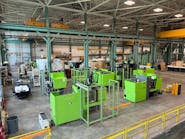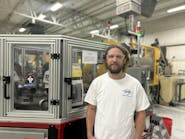Process monitoring and predictive maintenance can help plastics processors operate their machinery more efficiently and increase uptime by reducing unplanned maintenance.
Three software providers in the arena, Senseye, DELMIAworks and Kistler, recently upgraded or expanded their offerings.
Senseye
Senseye, a developer of cloud-based predictive maintenance software, in June announced the launch of its new plug-and-play Senseye PdM Starter Packs to help manufacturers, including plastics processors, rapidly launch a predictive maintenance program.
The Starter Packs include use not only of the predictive maintenance software, but also sensors that can attach to basic equipment including fans, pumps and motors, said Niall Sullivan, Senseye’s global marketing manager.
Senseye PdM, the predictive maintenance software, already accepts data (such as melt temperature, melting times and motor condition) from sensors and programmable logic controllers built into many modern injection molding machines and other plastics processing equipment. However, some older equipment and auxiliary equipment may be lacking the necessary sensors or control units to facilitate process monitoring and predictive maintenance.
To assist in data collection for those pieces of equipment, Senseye has partnered with several undisclosed sensor manufacturers to offer sensors configured to work with Senseye PdM software.
The Starter Packs also can help companies that have not previously collected process data to quickly deploy a predictive maintenance program, according to the company.
“We have a lot of customers or prospects coming to us who don’t necessarily have data or hardware to get started with predictive maintenance,” Sullivan said. “What we have done is, essentially, we’ve packaged up hardware to be used with our software so that businesses can get up and running with predictive maintenance as quickly as possible.”
The Senseye-provided sensors can monitor conditions including vibration, pressure, temperature, and current, Sullivan said.
The software collects and analyzes data in real time from machines and third-party sensors and examines historic performance when making its predictions. Senseye’s PdM software can monitor an unlimited number of machines, which would be expensive or impossible with humans analyzing the data.
Organizations across a range of sectors, including plastics processors, have halved levels of unplanned downtime, streamlined spare-parts inventories and cut maintenance costs by up to 40 percent, according to the company.
“We often speak to potential customers that are very early on their predictive maintenance journey, but are keen [to] get started on a project to appreciate its potential and develop a broader business case," said Simon Kampa, CEO of Senseye. “That’s why we have introduced Senseye PdM Starter Packs. Whether they have sensor data or not, organizations of all sizes can take a plug-and-play approach to data capture and start reaping the benefits of PdM in as short a time as possible.”
A processor would select the number of machines to be monitored and choose between wireless and wired sensor options, according to the company.
The wireless sensors mount using magnets for rapid installation, and provide basic condition monitoring on motors, pumps, compressors and many other industrial machines. They have embedded batteries that typically provide a lifespan of seven to 10 years, and capture simple vibration, temperature and electrical current data that they transmit wirelessly to an included cellular gateway. The wireless solution is currently only certified for use in Europe, according to the company.
The wired solution uses higher-quality sensors from a leading global manufacturer and provide more comprehensive measurements, according to Senseye. The wired sensors capture vibration, temperature and speed of rotation data from rotating machinery, and can detect common failure modes such as shaft imbalance and bearing misalignment.
Senseye is based in Southampton, England, but has a U.S. office in Nashville, Tenn.
DELMIAworks
DELMIAworks (formerly IQMS) provides manufacturers with real-time enterprise resource planning (ERP) software developed especially for manufacturing processes.
DELMIAworks provides predictive maintenance tools including real-time production and process monitoring by collecting data from existing PLCs on production equipment as well as additional sensors that can be installed by customers.
One of the most recent updates to the software was the addition of Shopworks, a module that provides work instructions to machine operators as they stand at an injection molding machine or other piece of industrial equipment.
The instructions typically appear on a wired or wireless tablet at the operator’s workstation. It is accessible on any device through a web browser.
“It might say, when the press opens and the parts come off, I want you to weigh the parts, and I want you to tell me which ones don’t weigh between this number and this number, or I want you to take this measurement, and I want you to record it,” said Steve Bieszczat, chief marketing officer at DELMIAworks.
Other typical instructions might involve the trimming of flash or instructions for boxing the finished parts. Shopworks can tell workers when and how to set up for the next job, or it can walk them through tasks including final part assembly.
“It gives exact instructions to the operator about what steps to take, and it makes them do those steps,” Bieszczat said. “They are recorded as part of a production process.”
It frees manufacturers from having to rely on manually based paper reporting that is prone to inaccuracy.
The addition of the Shopworks module makes it simple for an operator, with relatively little training, to see and easily follow instructions. The operator doesn’t need to navigate through menus of information to find what he needs.
“It’s kind of like an ATM machine,” Bieszczat said. “It just shows them exactly what they need to know when they need to know it.”
The Shopworks module can be particularly beneficial in a labor environment where manufacturers find it challenging to find and retain skilled workers.
“It’s the No. 1 issue in most manufacturing industries,” Bieszczat said. “The more information and the more concise the information you can provide to the machine operator, the better chance you have of getting a relatively unskilled new person up to speed quickly.”
This software enables an operator to do what they need to do without a lot of training, he said.
Kistler
Kistler, in its latest update to its ComoNeo process monitoring software, has added new features to improve product quality and process efficiency for injection molders, according to the company.
For years, Kistler’s customers in the plastics processing industry have used ComoNeo software for cavity pressure monitoring. Users can choose from a series of monitoring and control functions to improve their injection molding processes, and artificial intelligence features assist in model-based predictions for parts quality.
New upgrades included in ComoNeo 4.1 include WLAN (wireless local area network) compatibility for the first time. A normal commercial USB stick with wi-fi capability is all that is needed to integrate the system into a company’s existing network via WLAN. That means users can now connect the process monitoring system to the production environment wirelessly.
The new version also includes more accurate monitoring of the pressure curves in all cavities, according to the company. The improved precision is especially helpful when users need to evaluate individual events or the entire profile for compliance with critical tolerances. Users can set quality criteria manually.
ComoNeo 4.1 also includes new software modules that respond to increased requirements for production records in the medical technology industry. The addition of ComoNeoLOG to ComoNeo ensures an accurate audit trail by providing secure, time-indexed electronic storage of all user activities that involve changing or deleting electronic records.
The new ComoNeo version 4.1 also includes an improved user interface, according to the company. The “External UI” function allows users to view external data, such as production data from ComoDataCenter or an MES, on ComoNeo’s display. In addition, the ComoNeo UI can be viewed on a machine control via VNC (virtual network computing).
Bruce Geiselman, senior staff reporter
Contact:
DELMIAworks, Paso Robles, Calif., 805-227-1122, www.3ds.com/delmiaworks
Kistler Instrument Corp., Novi, Mich., 248-668-6900, www.kistler.com
Senseye USA, Nashville, Tenn., 415 523-0447, www.senseye.io
Bruce Geiselman | Senior Staff Reporter
Senior Staff Reporter Bruce Geiselman covers extrusion, blow molding, additive manufacturing, automation and end markets including automotive and packaging. He also writes features, including In Other Words and Problem Solved, for Plastics Machinery & Manufacturing, Plastics Recycling and The Journal of Blow Molding. He has extensive experience in daily and magazine journalism.






